Impacts of Cyclones on Arctic Clouds during Autumn in the Early 21st Century
Abstract
:1. Introduction
2. Data and Methods
2.1. Data
2.2. Methods
3. Statistical Connection between Autumn Cloud Change and Cyclone Activities
4. Further Insight into the Influence of Cyclones on Cloud
4.1. Climatology of Cloud Vertical Profile over Different Surface Conditions
4.2. Impact of Cyclones on Cloud Fractions
4.2.1. Variation of Cloud Fraction on Cyclone Days and No-Cyclone Days
4.2.2. Atmospheric Conditions in Cyclones
4.2.3. Local Vertical Atmospheric Conditions for Cloud Formation on Cyclone Days
5. Conclusions
6. Discussion
Author Contributions
Funding
Data Availability Statement
Conflicts of Interest
References
- Stroeve, J.; Holland, M.M.; Meier, W.; Scambos, T.; Serreze, M. Arctic sea ice decline: Faster than forecast. Geophys. Res. Lett. 2007, 34, L09501. [Google Scholar] [CrossRef]
- Screen, J.A.; Simmonds, I. The central role of diminishing sea ice in recent Arctic temperature amplification. Nature 2010, 464, 1334–1337. [Google Scholar] [CrossRef] [PubMed] [Green Version]
- Lee, H.J.; Kwon, M.; Yeh, S.W.; Kwon, Y.O.; Park, W.; Park, J.-H.; Kim, Y.H.; Alexander, M.A. Impact of Poleward Moisture Transport from the North Pacific on the Acceleration of Sea Ice Loss in the Arctic since 2002. J. Clim. 2017, 30, 6757–6769. [Google Scholar] [CrossRef]
- Clark, J.P.; Lee, S. The role of the Tropically Excited Arctic Warming Mechanism on the warm Arctic cold continent surface air temperature trend pattern. Geophys. Res. Lett. 2019, 46, 8490–8499. [Google Scholar] [CrossRef]
- Curry, J.; Rossow, W.B.; Randall, D.; Schramm, J.L. Overview of Arctic Cloud and radiation characteristics. J. Clim. 1996, 9, 1731–1764. [Google Scholar] [CrossRef]
- Vavrus, S. The impact of cloud feedbacks on Arctic climate under greenhouse forcing. J. Clim. 2004, 17, 603–615. [Google Scholar] [CrossRef]
- Kay, J.E.; L’Ecuyer, T. Observational constraints on Arctic Ocean clouds and radiative fluxes during the early 21st century. J. Geophys. Res. Atmos. 2013, 118, 7219–7236. [Google Scholar] [CrossRef]
- Yi, L.; Li, K.F.; Chen, X.; Tung, K.K. Arctic Fog Detection Using Infrared Spectral Measurements. J. Atmos. Ocean. Technol. 2019, 36, 1643–1656. [Google Scholar] [CrossRef]
- Intrieri, J.M.; Fairall, C.W.; Shupe, M.D.; Persson, P.O.G.; Andreas, E.L.; Guest, P.S.; Moritz, R.E. An annual cycle of Arctic surface cloud forcing at SHEBA. J. Geophys. Res. 2002, 107, 8039. [Google Scholar] [CrossRef]
- Wendisch, M.; Yang, P.; Ehrlich, A. Amplified climate changes in the Arctic: Role of clouds and atmospheric radiation. Sitzungsber. Saechs. Akad. Wiss. Leipzig. Math.-Naturwiss. Kl. 2013, 132, 1–34. [Google Scholar]
- Przybylak, R. The Climate of the Arctic, 2nd ed.; Atmospheric and Oceanographic Sciences Library; Springer: Berlin/Heidelberg, Germany, 2016; Volume 52, p. 279. [Google Scholar] [CrossRef]
- Wang, X.; Key, J.R. Cloud, and Radiation Properties Based on the AVHRR Polar Pathfinder Dataset. Part I: Spatial and Temporal Characteristics. J. Clim. 2005, 18, 2558–2574. [Google Scholar] [CrossRef] [Green Version]
- Kay, J.E.; Gettelman, A. Cloud influence on and response to seasonal Arctic sea ice loss. J. Geophys. Res. 2009, 114, D18204. [Google Scholar] [CrossRef]
- Krikken, F.; Hazeleger, W. Arctic Energy Budget in Relation to Sea Ice Variability on Monthly-to-Annual Time Scales. J. Clim. 2015, 28, 6335–6350. [Google Scholar] [CrossRef]
- Yamanouchi, T. Arctic warming by cloud radiation enhanced by moist air intrusion observed at Ny-Ålesund, Svalbard. Polar Sci. 2019, 21, 110–116. [Google Scholar] [CrossRef]
- Philipp, D.; Stengel, M.; Ahrens, B. Analyzing the Arctic Feedback Mechanism between Sea Ice and Low-Level Clouds Using 34 Years of Satellite Observations. J Clim. 2020, 33, 7479–7501. [Google Scholar] [CrossRef]
- Eastman, R.; Warren, S.G. Interannual variations of Arctic cloud types in relation to sea ice. J. Clim. 2010, 23, 4216–4232. [Google Scholar] [CrossRef]
- Wu, D.L.; Lee, J.N. Arctic low cloud changes as observed by MISR and CALIOP: Implication for the enhanced autumnal warming and sea ice loss. J. Geophys Res. 2012, 117, D07107. [Google Scholar] [CrossRef] [Green Version]
- Schweiger, A.J.; Lindsay, R.W.; Vavrus, S.; Francis, J.A. Relationships between Arctic Sea Ice and Clouds during Autumn. J. Clim. 2008, 21, 4799–4810. [Google Scholar] [CrossRef]
- Sato, K.; Inoue, J.; Kodama, Y.-M.; Overland, J.E. Impact of Arctic sea-ice retreat on the recent change in cloud-base height during autumn. Geophys. Res. Lett. 2012, 39, L10503. [Google Scholar] [CrossRef] [Green Version]
- Vavrus, S.; Holland, M.M.; Bailey, D.A. Changes in Arctic clouds during intervals of rapid sea ice loss. Clim. Dyn. 2011, 36, 1475–1489. [Google Scholar] [CrossRef] [Green Version]
- Liu, Y.; Key, J.R.; Vavrus, S.; Woods, C. Time Evolution of the Cloud Response to Moisture Intrusions into the Arctic during Winter. J. Clim. 2018, 31, 9389–9405. [Google Scholar] [CrossRef] [Green Version]
- Sedlar, J.; Tjernström, M.; Rinke, A.; Orr, A.; Cassano, J.; Fettweis, X.; Heinemann, G.; Seefeldt, M.; Solomon, A.; Matthes, H.; et al. Confronting Arctic troposphere, clouds, and surface energy budget representations in regional climate models with observations. J. Geophys. Res. Atmos. 2020, 125, e2019JD031783. [Google Scholar] [CrossRef]
- Inoue, J.; Sato, K.; Rinke, A.; Cassano, J.J.; Fettweis, X.; Heinemann, G.; Matthes, H.; Orr, A.; Phillips, T.; Seefeldt, M.; et al. Clouds and radiation processes in regional climate models evaluated using observations over the ice-free Arctic Ocean. J. Geophys. Res. Atmos. 2021, 126, e2020JD033904. [Google Scholar] [CrossRef]
- Shupe, M.D.; Rex, M.; Blomquist, B.; Persson, P.O.G.; Schmale, J.; Uttal, T.; Althausen, D.; Angot, H.; Archer, S.; Bariteau, L.; et al. Overview of the MOSAiC expedition: Atmosphere. Elem. Sci. Anthr. 2022, 10, 00060. [Google Scholar] [CrossRef]
- Stewart, R.E.; Szeto, K.K.; Reinking, R.F.; Clough, S.A.; Ballard, S.P. Midlatitude cyclonic cloud systems and their features affecting large scales and climate. Rev. Geophys. 1998, 36, 245–273. [Google Scholar] [CrossRef] [Green Version]
- Xu, H.; Xu, M.; Xie, S.; Wang, Y. Deep Atmospheric Response to the Spring Kuroshio over the East China Sea. J. Clim. 2011, 24, 4959–4972. [Google Scholar] [CrossRef]
- Naud, C.M.; Posselt, D.J.; van den Heever, S.C. Observational Analysis of Cloud and Precipitation in Midlatitude Cyclones: Northern versus Southern Hemisphere Warm Fronts. J. Clim. 2012, 25, 5135–5151. [Google Scholar] [CrossRef] [Green Version]
- Naud, C.M.; Booth, J.F.; Posselt, D.J.; van den Heever, S.C. Multiple satellite observations of cloud cover in extratropical cyclones. J. Geophys. Res. Atmos. 2013, 118, 9982–9996. [Google Scholar] [CrossRef] [Green Version]
- Gulev, S.K.; Zolina, O.; Grigoriev, S. Extratropical cyclone variability in the Northern Hemisphere winter from the NCEP/NCAR reanalysis data. J. Clim. Dyn. 2001, 17, 795–809. [Google Scholar] [CrossRef]
- Zhang, X.D.; Walsh, J.E.; Zhang, J.; Bhatt, U.S.; Ikeda, M. Climatology and Interannual Variability of Arctic Cyclone Activity: 1948–2002. J. Clim. 2004, 17, 2300–2317. [Google Scholar] [CrossRef]
- Sepp, M.; Jaagus, J. Changes in the activity and tracks of Arctic cyclones. J. Clim. Chang. 2011, 105, 577–595. [Google Scholar] [CrossRef]
- Inoue, J.; Hori, M.E. Arctic cyclogenesis at the marginal ice zone: A contributory mechanism for the temperature amplification? Geophys. Res. Lett. 2011, 38, L12502. [Google Scholar] [CrossRef]
- Day, J.J.; Holland, M.M.; Hodges, K.I. Seasonal differences in the response of Arctic cyclones to climate change in CESM1. Clim. Dyn. 2018, 50, 3885–3903. [Google Scholar] [CrossRef] [Green Version]
- Inoue, J.; Tobo, Y.; Taketani, F.; Sato, K. Oceanic supply of ice-nucleating particles and its effect on ice cloud formation: A case study in the Arctic Ocean during a cold-air outbreak in early winter. Geophys. Res. Lett. 2021, 48, e2021GL094646. [Google Scholar] [CrossRef]
- Waseda, T.; Webb, A.; Sato, K.; Inoue, J.; Kohout, A.; Penros, B.; Penrose, S. Correlated Increase of High Ocean Waves and Winds in the Ice-Free Waters of the Arctic Ocean. Sci. Rep. 2018, 8, 4489. [Google Scholar] [CrossRef] [PubMed] [Green Version]
- Sato, K.; Inoue, J. Comparison of Arctic sea ice thickness and snow depth estimates from CFSR with in situ observations. Clim. Dyn. 2018, 50, 289–301. [Google Scholar] [CrossRef] [Green Version]
- Huschke, R.E. Arctic Cloud Statistics from “Air Calibrated” Surface Weather Observations; Mem. RM-6173-PR; Rand Corp.: Santa Monica, CA, USA, 1969; p. 79. [Google Scholar]
- Doelling, D.R.; Loeb, N.G.; Keyes, D.F.; Nordeen, M.L.; Morstad, D.; Nguyen, C.; Wielicki, B.A.; Young, D.F.; Sun, M. Geostationary Enhanced Temporal Interpolation for CERES Flux Products. J. Atmos. Ocean. Technol. 2013, 30, 1072–1090. [Google Scholar] [CrossRef]
- Huang, Y.; Dong, X.; Xi, B.; Dolinar, E.K.; Stanfield, R.E.; Qiu, S. Quantifying the Uncertainties of Reanalyzed Arctic Cloud and Radiation Properties Using Satellite Surface Observations. J. Clim. 2017, 30, 8007–8029. [Google Scholar] [CrossRef]
- Zhan, Y.; Di Girolamo, L.; Davies, R.; Moroney, C. Instantaneous Top-of-Atmosphere Albedo Comparison between CERES and MISR over the Arctic. Remote Sens. 2018, 10, 1882. [Google Scholar] [CrossRef] [Green Version]
- Chepfer, H.; Bony, S.; Winker, D.; Cesana, G.; Dufresne, J.L.; Minnis, P.; Stubenrauch, C.J.; Zeng, S. The GCM-Oriented CALIPSO Cloud Product (CALIPSO-GOCCP). J. Geophys. Res. 2010, 115, D00H16. [Google Scholar] [CrossRef]
- Barton, N.P.; Klein, S.A.; Boyle, J.S.; Zhang, Y.Y. Arctic synoptic regimes: Comparing domain-wide Arctic cloud observations with CAM4 and CAM5 during similar dynamics. J. Geophys. Res. 2012, 117, D15205. [Google Scholar] [CrossRef]
- English, J.M.; Gettelman, A.; Henderson, G.R. Arctic Radiative Fluxes: Present-Day Biases and Future Projections in CMIP5 Models. J. Clim. 2015, 28, 6019–6038. [Google Scholar] [CrossRef]
- Cesana, G.; Chepfer, H. How well do climate models simulate cloud vertical structure? A comparison between CALIPSO-GOCCP satellite observations and CMIP5 models. Geophys. Res. Lett. 2012, 39, L20803. [Google Scholar] [CrossRef] [Green Version]
- Boudala, F.S.; Milbrandt, J.A. Evaluations of the Climatologies of Three Latest Cloud Satellite Products Based on Passive Sensors (ISCCP-H, Two CERES) against the CALIPSO-GOCCP. Remote Sens. 2021, 13, 5150. [Google Scholar] [CrossRef]
- Blender, R.; Fraedrich, K.; Lunkeit, F. Identification of cyclone-track regimes in the North Atlantic. Q. J. R. Meteorol. Soc. 1997, 123, 727–741. [Google Scholar] [CrossRef]
- Hart, R.E. A Cyclone Phase Space Derived from Thermal Wind and Thermal Asymmetry. Mon. Weather Rev. 2003, 131, 585–616. [Google Scholar] [CrossRef]
- Sinclair, M.R. An Objective Cyclone Climatology for the Southern Hemisphere. Mon. Weather Rev. 1994, 122, 2239–2256. [Google Scholar] [CrossRef]
- Sun, R.P.; Diao, Y.N. Statistical Analysis of Spatial Temporal Characteristics of Extratropical cyclone activity in the northern hemisphere in 1979–2017. Period. Ocean. Univ. China 2020, 50, 12–21. [Google Scholar] [CrossRef]
- Nielsen, J.W.; Dole, R.M. A survey of extratropical cyclone characteristics during GALE. Mon. Weather Rev. 1992, 120, 1156–1168. [Google Scholar] [CrossRef]
- Field, P.R.; Wood, R. Precipitation and cloud structure in midlatitude cyclones. J. Clim. 2007, 20, 233–254. [Google Scholar] [CrossRef]
- Poore, K.D.; Wang, J.; Rossow, W.B. Cloud Layer Thicknesses from a Combination of Surface and Upper-Air Observations. J. Clim. 1995, 8, 550–568. [Google Scholar] [CrossRef]
- Sedlar, J.; Shupe, M.D.; Tjernström, M. On the Relationship between Thermodynamic Structure and Cloud Top, and Its Climate Significance in the Arctic. J. Clim. 2012, 25, 2374–2393. [Google Scholar] [CrossRef]
- Simpfendoerfer, L.F.; Verlinde, J.; Harrington, J.Y.; Shupe, M.D.; Chen, Y.S.; Clothiaux, E.E.; Golaz, J.C. Formation of Arctic stratocumuli through atmospheric radiative cooling. J. Geophys. Res. Atmos. 2019, 124, 9644–9664. [Google Scholar] [CrossRef]
- Simmonds, I.; Burke, C.; Keay, K. Arctic climate change as manifest in cyclone behavior. J. Clim. 2008, 21, 5777–5796. [Google Scholar] [CrossRef]
- Vihma, T.; Screen, J.; Tjernström, M.; Newton, B.; Zhang, X.; Popova, V.; Deser, C.; Holland, M.; Prowse, T. The atmospheric role in the Arctic water cycle: A review on processes, past and future changes, and their impacts. J. Geophys. Res. Biogeosci. 2016, 121, 586–620. [Google Scholar] [CrossRef] [Green Version]
- Vavrus, S.J.; Bhatt, U.S.; Alexeev, V.A. Factors Influencing Simulated Changes in Future Arctic Cloudiness. J. Clim. 2011, 24, 4817–4830. [Google Scholar] [CrossRef]
- Gong, T.; Feldstein, S.; Lee, S. The role of downward infrared radiation in the recent Arctic winter warming trend. J. Clim. 2017, 30, 4937–4949. [Google Scholar] [CrossRef]
- Dong, X.; Mace, G.G. Arctic stratus cloud properties and radiative forcing derived from ground-based data collected at Barrow, Alaska. J. Clim. 2003, 16, 445–461. [Google Scholar] [CrossRef]
- Curry, J.A.; Ebert, E.E. Annual cycle of radiation fluxes over the Arctic Ocean: Sensitivity of cloud optical properties. J. Clim. 1992, 5, 1267–1280. [Google Scholar] [CrossRef]
- Shupe, M.D.; Intrieri, J.M. Cloud Radiative Forcing of the Arctic Surface: The Influence of Cloud Properties, Surface Albedo, and Solar Zenith Angle. J. Clim. 2004, 17, 616–628. [Google Scholar] [CrossRef]
- Hori, M.E.; Inoue, J.; Dethloff, K.; Kustov, V. Near-tropopause bias in the Russian radiosonde-observed air temperature during the YOPP special observing periods in 2018. Polar Sci. 2021, 27, 1873–9652. [Google Scholar] [CrossRef]
- Simmons, A.J.; Poli, P. Arctic warming in era-interim and other analyses. Q. J. R. Meteorol. Soc. 2015, 141, 1147–1162. [Google Scholar] [CrossRef]
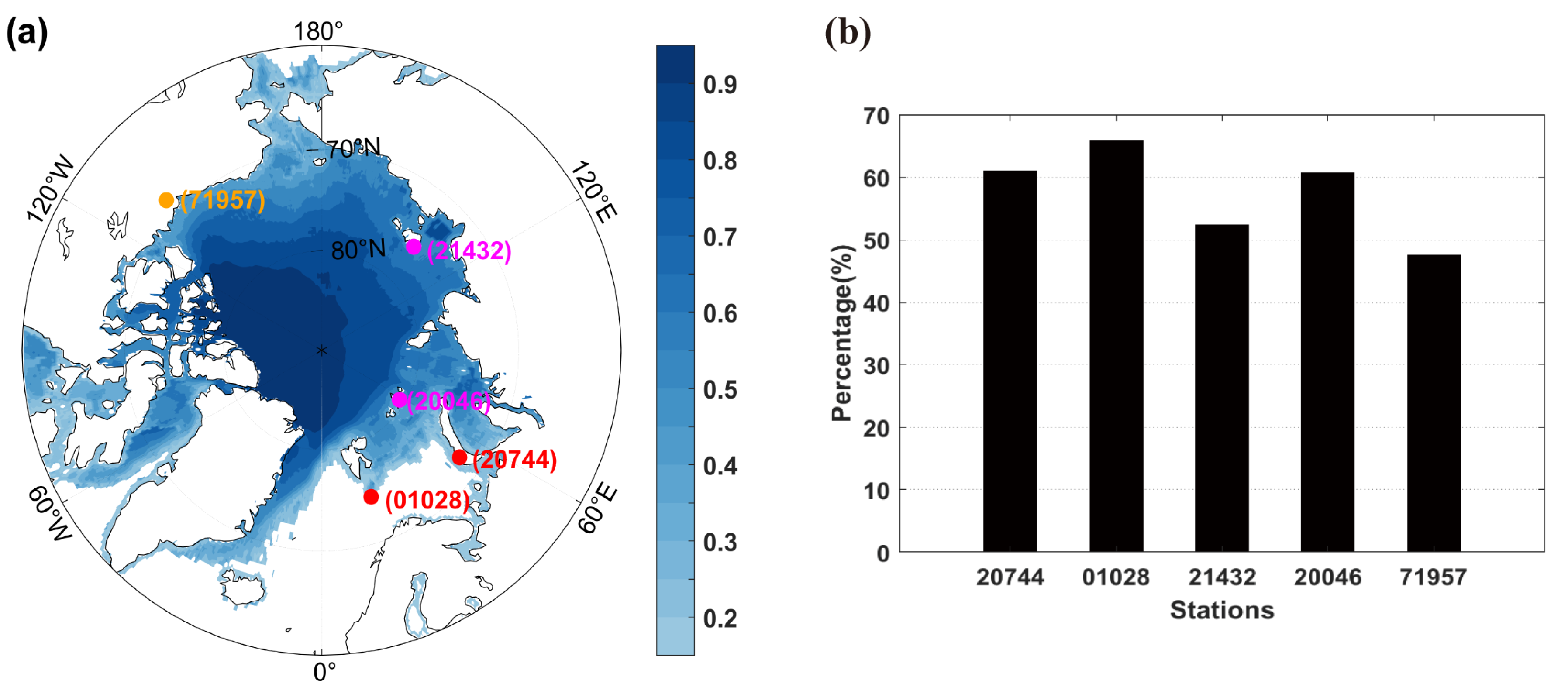

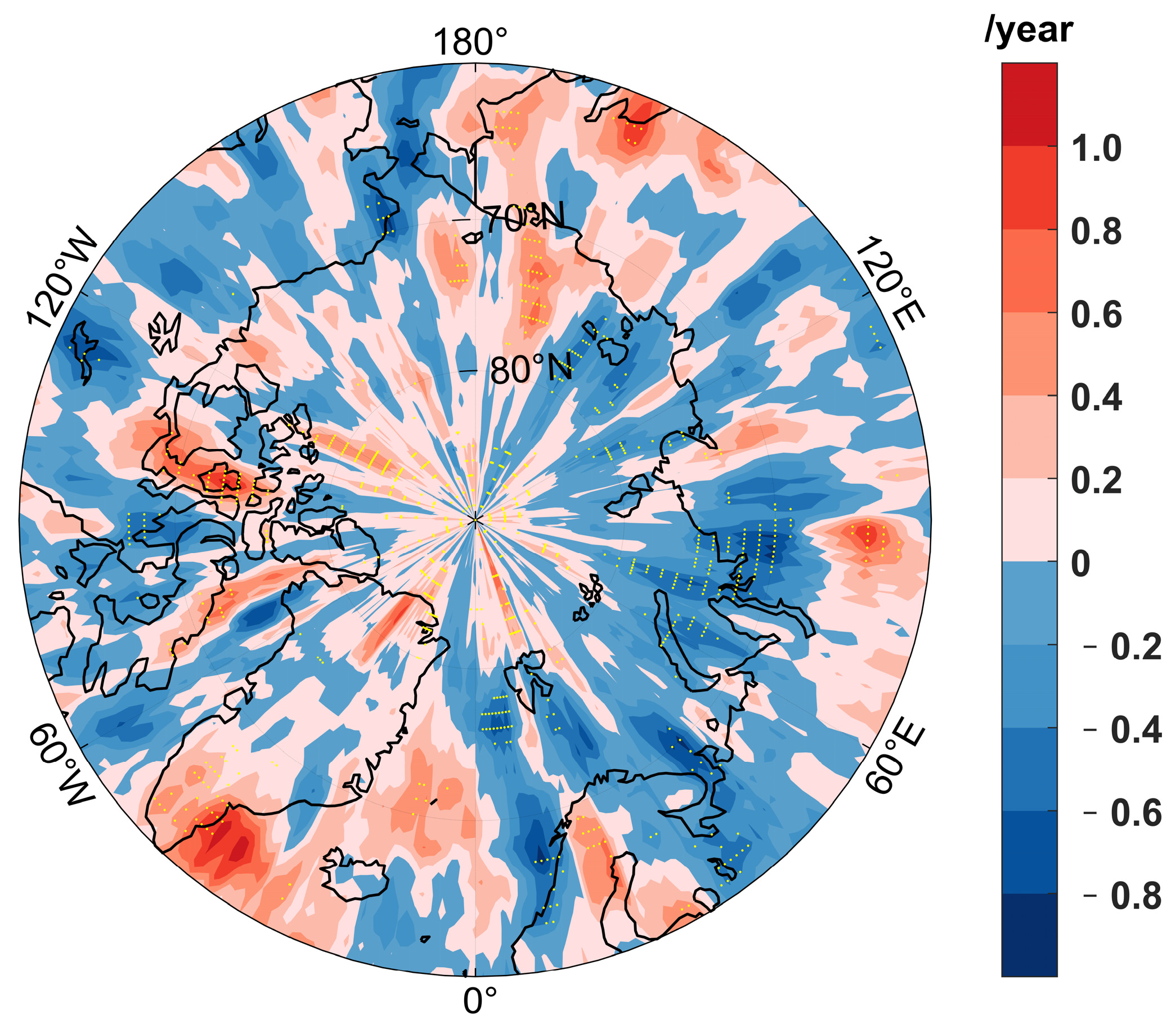



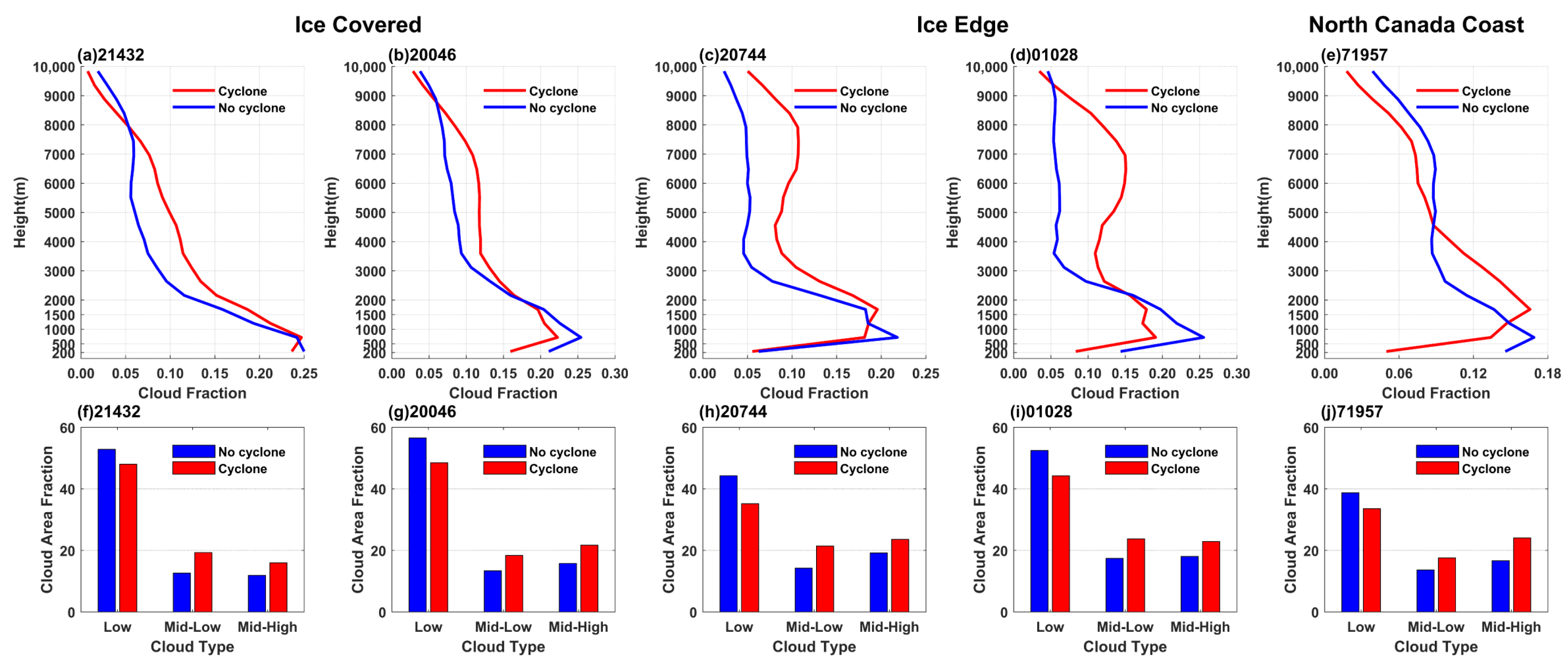

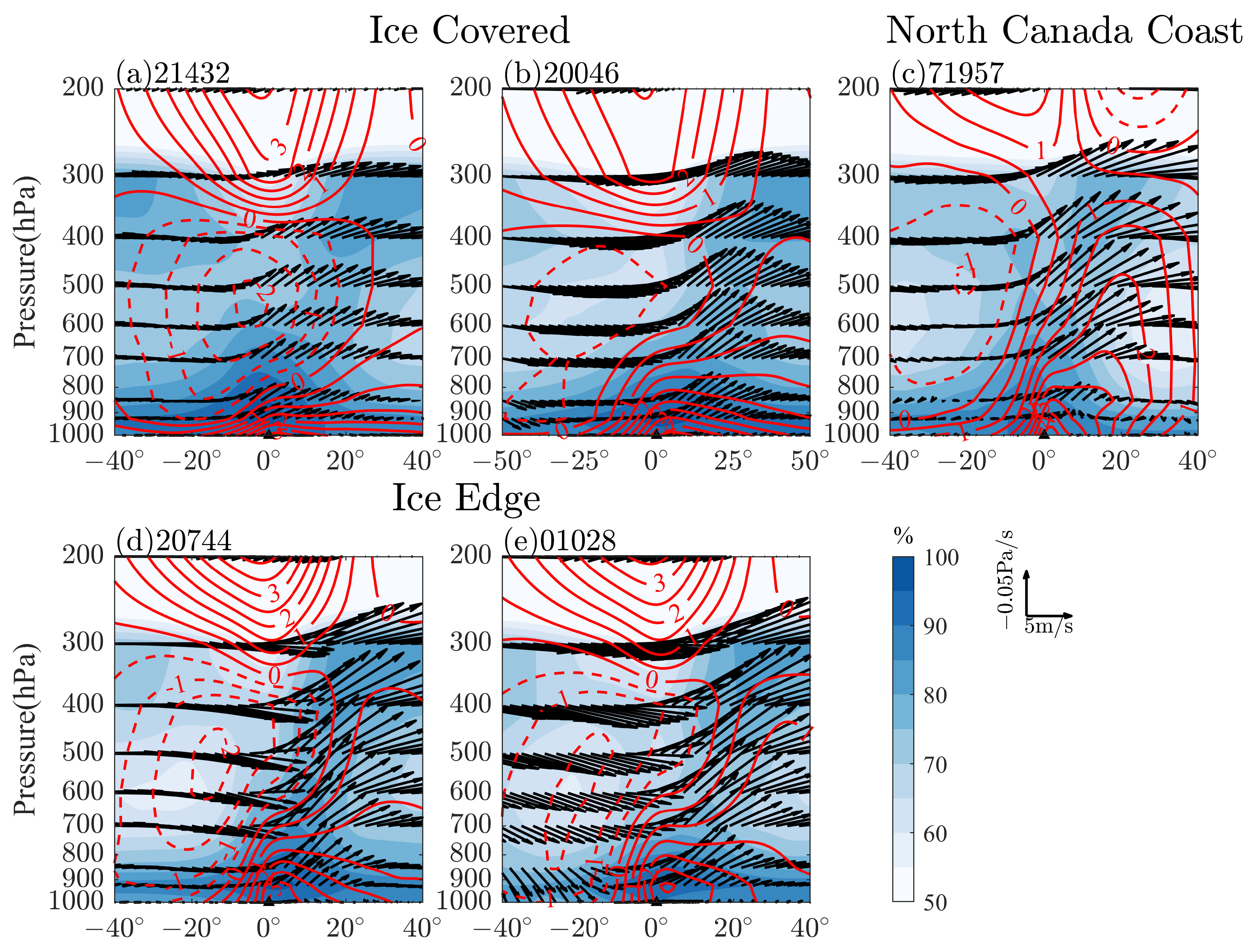
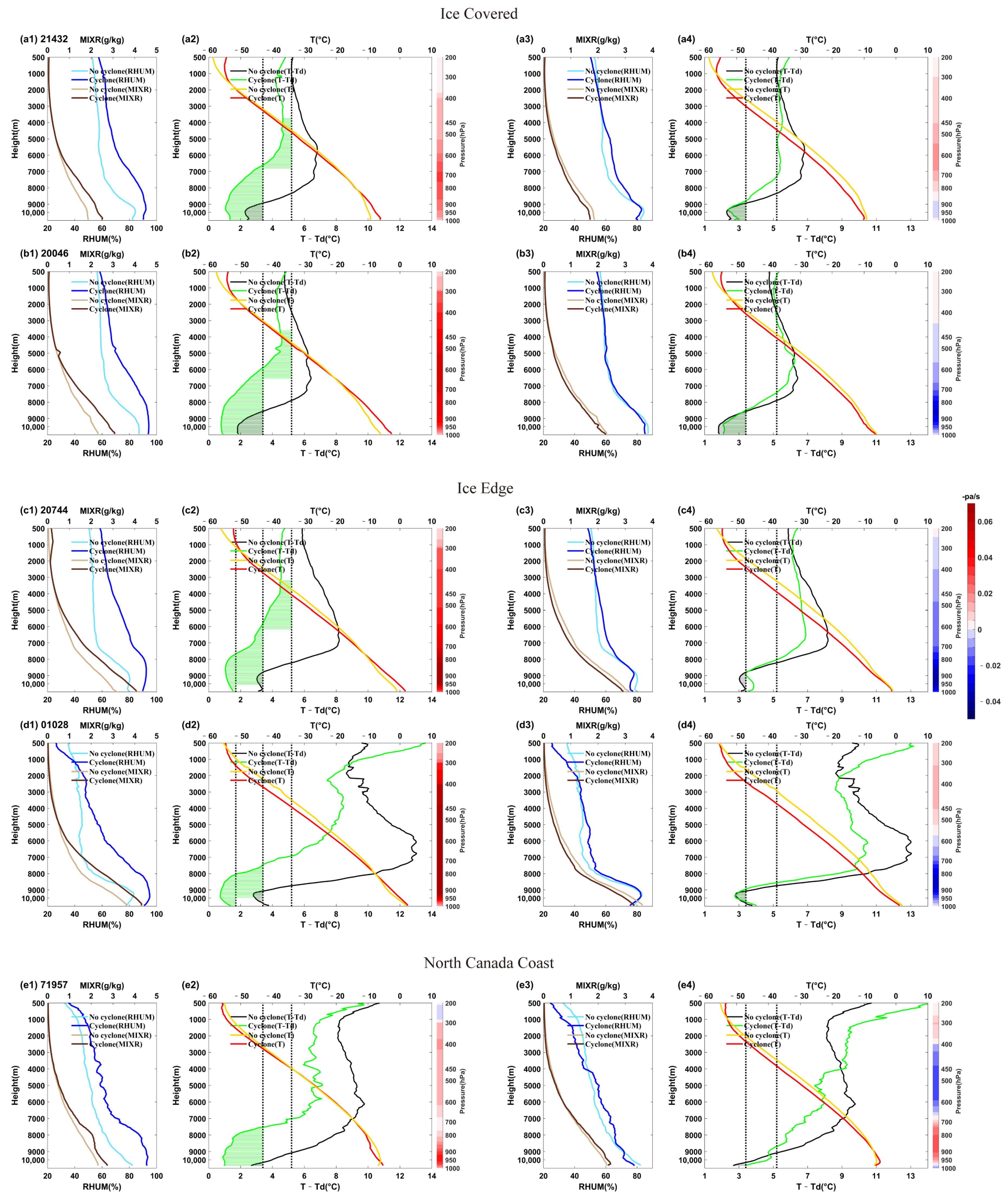

| Ground Surface | Station | Cyclone Days |
|---|---|---|
| Ice-covered | 21432 | 810 |
| 20046 | 938 | |
| Ice edge | 20744 | 944 |
| 01028 | 1020 | |
| Ice-covered land coast station | 71957 | 735 |
Disclaimer/Publisher’s Note: The statements, opinions and data contained in all publications are solely those of the individual author(s) and contributor(s) and not of MDPI and/or the editor(s). MDPI and/or the editor(s) disclaim responsibility for any injury to people or property resulting from any ideas, methods, instructions or products referred to in the content. |
© 2023 by the authors. Licensee MDPI, Basel, Switzerland. This article is an open access article distributed under the terms and conditions of the Creative Commons Attribution (CC BY) license (https://creativecommons.org/licenses/by/4.0/).
Share and Cite
Liu, X.; Diao, Y.; Sun, R.; Gong, Q. Impacts of Cyclones on Arctic Clouds during Autumn in the Early 21st Century. Atmosphere 2023, 14, 689. https://doi.org/10.3390/atmos14040689
Liu X, Diao Y, Sun R, Gong Q. Impacts of Cyclones on Arctic Clouds during Autumn in the Early 21st Century. Atmosphere. 2023; 14(4):689. https://doi.org/10.3390/atmos14040689
Chicago/Turabian StyleLiu, Xue, Yina Diao, Ruipeng Sun, and Qinglong Gong. 2023. "Impacts of Cyclones on Arctic Clouds during Autumn in the Early 21st Century" Atmosphere 14, no. 4: 689. https://doi.org/10.3390/atmos14040689





